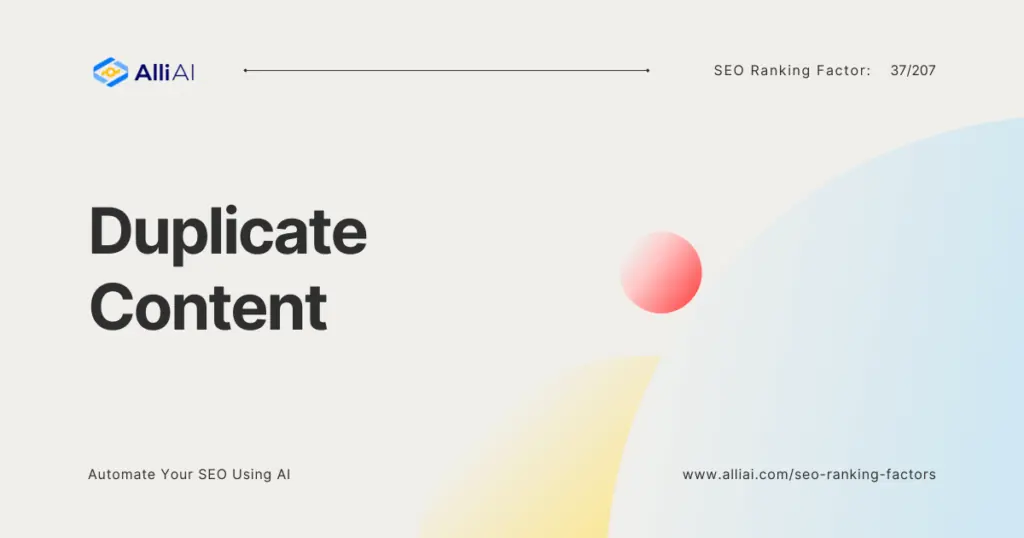What Does Duplicate Content Mean?
Duplicate content refers to substantial blocks of content within or across websites that either completely match other content or are appreciably similar. Essentially, it’s when the same content appears in more than one place on the internet. This can negatively impact a website’s SEO because search engines might not know which version of the content to show in search results, leading to a dilution in search rankings.
Where Does Duplicate Content Fit Into The Broader SEO Landscape?
Duplicate content significantly impacts SEO as it can dilute ranking potential across pages, making it harder for search engines to determine which version to index or rank. This can lead to issues such as decreased visibility and split link equity, as inbound links might point to multiple versions of the same content instead of reinforcing a single page. Search engines like Google discourage duplicate content because it can create a poor user experience and may be interpreted as manipulative or spammy, potentially leading to penalties or reduced rankings. Effective management of duplicate content involves employing strategies like setting up 301 redirects, using the canonical link element, or ensuring consistent internal linking practices to signal to search engines which versions of content are priorities for indexing.
Real Life Analogies or Metaphors to Explain Duplicate Content
1. Photocopying a Book: Duplicate content on a website is like making photocopies of the same book. If you try to sell those copies as unique items in different bookstores, it confuses customers and undermines the value of the original.
2. Cooking the Same Dish: Imagine if a chef prepared the same dish but served it at different tables under different names. Diners might feel deceived or find the menu repetitive and untrustworthy.
3. Painting Original Art: Duplicate content is akin to a painter using a stencil to create multiple pictures. While each painting might look similar, they lack the originality and unique brush strokes that make an original painting valuable.
4. Echo in a Canyon: If content on a website is duplicated, it’s like shouting into a canyon and hearing the same phrase echoed back multiple times. It doesn’t add any new information or vary the conversation; it just repeats what was already said.
How the Duplicate Content Functions or is Implemented?
1. Definition: Duplicate content refers to substantial blocks of content within or across domains that either completely match other content or are appreciably similar.
2. Detection: Search engines like Google use sophisticated algorithms to identify duplicate content. These algorithms analyze text elements and structural aspects to find matches or near-matches across web pages.
3. Canonicalization: Webmasters use the canonical tag to indicate the preferred version of a set of duplicate pages. This helps search engines understand which version of the content to index and display in search results.
4. Handling by Search Engines:
– Consolidation of Ranking Signals: Search engines consolidate ranking signals (like links) from the duplicates to the canonical page, which can impact search rankings.
– Filtering in SERPs: Search engines filter out duplicate content in search results to enhance user experience, leaving only the most relevant version.
5. Impact on SEO: Duplicate content can dilute keyword relevance and can potentially lead to site-wide penalties if perceived as an attempt to manipulate search results.
6. Tools for Managing Duplicate Content:
– Google Search Console: Helps identify issues with duplicate content and how content is indexed.
– Copyscape: A tool for finding external duplicate content.
– Siteliner and Screaming Frog: For internal duplicate content identification.
7. Prevention Techniques:
– 301 Redirects: Redirecting duplicate pages to the original page can pass along ranking power.
– Using Noindex: This prevents search engines from indexing duplicate content.
– Improving Content Uniqueness: Rewriting or modifying content to add value and uniqueness.
Impact Duplicate Content has on SEO
Duplicate content can significantly impact a website’s SEO performance, rankings, and user experience in several ways:
1. Search Engine Rankings: When multiple pages contain the same or substantially similar content, search engines struggle to determine which version is most relevant to a given search query. This can lead to a dilution in the value of the content, causing all versions to potentially rank lower than a single, unique page might.
2. Link Equity: Links are a critical factor in SEO rankings. If duplicate content exists, backlinks might be spread across multiple versions of the same content rather than pointing to a single page. This dispersal dilutes link equity, reducing the potential ranking power of the content.
3. Crawl Budget: Search engines allocate a crawl budget to each website, which is the number of pages a search engine spider will crawl and index within a certain timeframe. Duplicate content consumes part of this budget, potentially preventing other, more unique content from being crawled and indexed.
4. User Experience: Users may become frustrated if they encounter similar or identical content across multiple pages of a website. This can lead to confusion, decreased user satisfaction, and increased bounce rates, which negatively impact SEO as search engines consider user engagement metrics as ranking factors.
5. Penalties and Filters: While there isn’t a direct penalty for duplicate content, search engines might apply filters to ensure that only one version of the content is included in search results, ignoring or excluding other duplicates. In some cases, extreme duplication might be mistaken for manipulative practices, leading to penalties or reduced rankings.
6. Wasted Resources: Managing duplicate content can lead to increased costs and wasted resources in content production, hosting, and maintenance, as efforts are duplicated unnecessarily. This inefficiency could be better used in enhancing other aspects of the website’s performance and user experience.
SEO Best Practices For Duplicate Content
1. Identify duplicate content by using tools such as Screaming Frog, Siteliner, or Google Search Console.
2. Determine whether the duplicate content is required or has value. If not, consider removing or consolidating it.
3. Use 301 redirects to redirect duplicate pages to the original content page.
4. Implement the canonical link element in the `` section of the HTML of the duplicate pages. Specify the URL of the original content page as the canonical URL.
5. Use the `rel=”canonical”` attribute linking to the original content within each duplicate page’s link element.
6. Where applicable, use the meta robots tag with the value “noindex, follow” to prevent duplicate content from being indexed while still allowing the search engine bots to crawl these pages.
7. Adjust your website’s internal linking structure to ensure that links are pointing to the original content rather than duplicates.
8. Regularly monitor your website for duplicate content issues and address them promptly as they arise.
9. If your site is multilingual, use the `hreflang` tag to differentiate between language and regional URL variations.
10. Update your XML sitemap frequently to reflect the preferred URLs for content to ensure search engines are indexing the correct pages.
Common Mistakes To Avoid
1. Identical Content Across Pages: Avoid using the exact same content on multiple pages of a website. Use canonical tags to indicate the preferred version of a page to search engines.
2. WWW vs. Non-WWW and HTTP vs. HTTPS: Ensure consistent URL structures across your site. Use 301 redirects to unify www vs. non-www and HTTP vs. HTTPS versions, and use canonical URLs.
3. Syndicated Content: When sharing content across different sites (syndication), include a link back to the original content and ask other publishers to use the canonical link pointing to your original content.
4. Similar Content on Multiple Pages: Alter content sufficiently to make each page unique, or consider merging pages if they are too similar, using 301 redirects to preserve SEO value.
5. Session IDs in URLs: Use cookies or rewrite sessions URLs to static URLs to avoid content duplication due to session ID parameters.
6. Printer-Friendly Versions of Content: Use a noindex tag or consolidate printer-friendly versions with original articles using canonical tags.
7. E-Commerce Product Descriptions: Write unique product descriptions; avoid manufacturer’s generic descriptions. Use canonical tags for products accessible by multiple URLs.
8. Language Variations: Use hreflang tags for content that is duplicated across different language versions to specify the language and regional targeting.
9. Pagination Issues: Use rel=”next” and rel=”prev” links to indicate paginated content series, helping search engines understand the sequence of pages.
10. Boilerplate Repetition: Limit the repeated use of the same text on multiple pages (like headers, footers, or call-to-action sections) and focus on creating unique content for each page.
By actively managing these aspects, you can prevent the adverse effects of duplicate content on your site’s search engine ranking.






